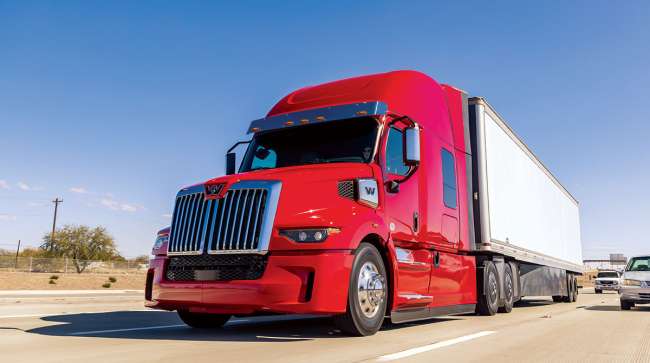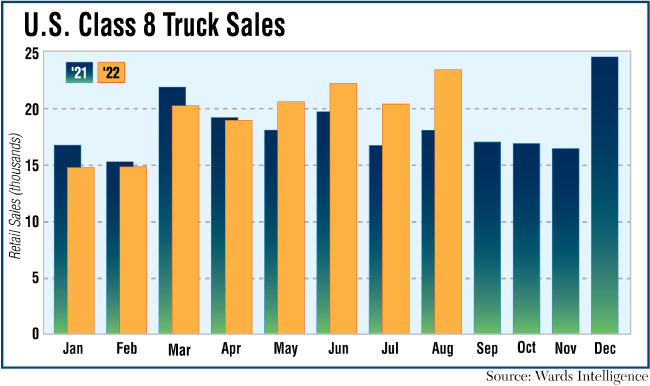Senior Reporter
Class 8 Sales in August Climb to Year’s Best

[Stay on top of transportation news: Get TTNews in your inbox.]
Class 8 U.S. retail sales in August reached their high point for the year, clearing 23,000 for a 29.7% increase compared with a year earlier, Wards Intelligence reported.
The month’s tally reached 23,581 compared with 18,176 in the 2021 period.
August’s total was about 15% higher compared with the steady rate of sales over the previous five months. July’s total was 20,513.
Year-to-date sales climbed 6.6% to 156,275 compared with 146,552 a year earlier.
Most truck makers posted double-digit sales gains in August, although one did not and another had a slight decline compared with a year earlier, according to Wards.

Freightliner, a brand of Daimler Truck North America, remained the market leader as sales jumped 47.2%, the second-highest gain, to 9,783, which was good for a 41.5% market share.
DTNA’s Western Star brand sold 604 trucks, an 18.7% improvement, and earned a 2.6% share.
Volvo Trucks North America, a Volvo Group brand, notched the largest increase, 88%, as sales climbed to 2,243 and a 9.5% share.
A year earlier, VTNA was just rebounding from a five-month strike at its truck assembly plant in Dublin, Va.
“That’s why a year-over-year comparison doesn’t make complete sense,” said Magnus Koeck, vice president of strategy at VTNA. “The remaining four months of the year will most likely be strong from an industry perspective and the original equipment manufacturers’ retail shares will be determined by who will manage the supply chain and their manufacturing output in the best way.”

Koeck
Volvo Group’s Mack Trucks brand increased sales by 6.6% to 1,594 for a 6.8% share.
Peterbilt Motors Co., a Paccar Inc. brand, showed the third-highest gain, 26.6%, as sales climbed to 3,298 for a 14% share.
Paccar’s Kenworth Truck Co. also notched a 14% share as sales rose 15.7% to 3,310.
International, a brand of Navistar Inc., reported a 4.1% decline in sales to 2,749, good for an 11.7% share.
The recent sales trend shows sales remain relatively flat on a per-day basis, said Don Ake, vice president of commercial vehicles at FTR.
“Truck makers continue to struggle to increase production due to persistent supply chain restrictions,” he added. “The availability of semiconductors remains the primary constraint.”

Gomez
Despite the highpoint in August, one truck dealer executive told Transport Topics he believes the rising prices of new trucks caused some potential buyers to have second thoughts, wait a bit longer or even decide to run their existing trucks for another year.
“While customers still need trucks, there has been a little bit more pushback on prices over this past quarter. That is the biggest recent change that I have seen,” said Robert Gomez, executive vice president of truck sales for Worldwide Equipment Enterprises Inc.
About 10% of Worldwide Equipment’s customers are questioning buying a truck in 2023, “but that doesn’t mean they won’t buy,” Gomez said. But upcoming tougher state and federal emissions rules have some people questioning when to purchase.
“There’s so much unknown,” Gomez said. “Some customers think the pricing will go down. Some feel that there will be additional availability in the second half of 2023. I think some customers don’t want to pay an increase of 15% over a truck that has been a 2.5% to 4% typical year-over-year increase.”
The prices are climbing with truck makers’ surcharges, plus vendor shortages that lead to build constraints that limit overall availability.

In this special edition of RoadSigns, hosts Seth Clevenger and Mike Freeze provide an inside look at Transport Topics' 2022 Top 100 Private Carriers list. Tune in above or by going to RoadSigns.ttnews.com.
He added, “While some relief in the supply chain may come, it would help truck makers build additional trucks, but would not necessarily reduce pricing.”
Knoxville, Tenn.-based Worldwide Equipment has locations in six states, including 15 full-service, multibrand medium- and heavy-duty dealerships, six satellite parts stores and 10 leasing locations, and 900 employees.
Meanwhile, nonprofit RMI projects the recently enacted Inflation Reduction Act’s climate-related incentives and the resulting “virtuous cycle” of increasing electric truck purchases and deployments of charging infrastructure will lead to far greater electric truck sales — that’s why it suggested by 2030, more than 60% of new truck sales could be electric, depending on supply chain issues.
But how will the network of chargers be supplied with consistent electricity?
California, a state that is a major proponent of electric truck transportation, in early September was gripped by a massive heat wave and residents were told to plan on not using their air conditioning units after 4 p.m. to slash demand for electricity, said Steve Tam, vice president of ACT Research. “And that’s without all these electric vehicles we think that are going to be added over the next four or five years. That seems to be something, especially, proponents are glossing over. It doesn’t seem like anybody is calling them out on it, either.”
At the same time, Andrew Wrobel, senior powertrain analyst at Rhein Associates, wrote recently: “Production of natural gas powered trucks is currently around 5,000 units. Well-to-wheel emissions strategies using renewable natural gas could increase natural gas adoption.”
Want more news? Listen to today's daily briefing below or go here for more info:

